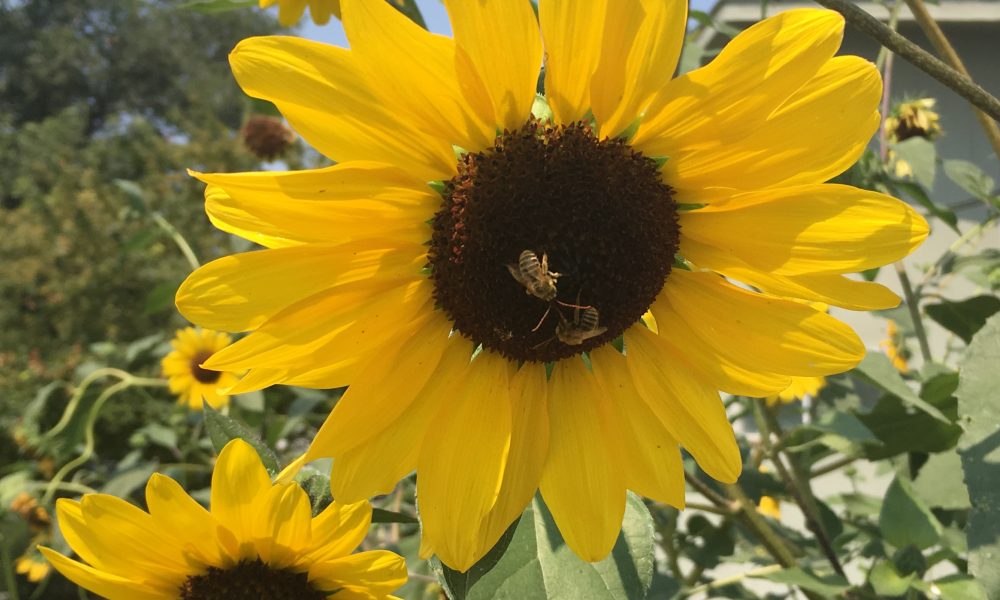 Honey bees are the most commonly cultivated bee species for pollination. (Max Egener/The Enterprise)
Honey bees are the most commonly cultivated bee species for pollination. (Max Egener/The Enterprise)
VALE – There’s a buzz in Oregon, and most of it is coming from Malheur County.
There are more bee colonies in Malheur than in any other county in Oregon, according to the last agricultural census conducted by the U.S. Department of Agriculture in 2012. The county had over 17,000 bee colonies, each with potentially more than 60,000 bees.
Behind cattle, bees are the second largest livestock product in the county.
Malheur’s contributions consistently help make Oregon one of the top bee producers in the country. By June, Oregon had the 10th highest number of bee colonies with 106,000, according to a federal survey.
Bee researchers say that the vegetation and climate in Malheur County make it an ideal place for raising bees. These often-overlooked insects play a vital role in the agricultural industry across the country because they pollinate crops. The recent emergence of problems such as colony collapse disorder, which leads to the rapid decline of entire colonies, has alarmed beekeepers and scientists.
The disorder isn’t well understood.
But research shows that commercial bee populations have remained steady since the mid-1990s, well before the disorder was discovered in 2006.
While there are over 500 different wild bee species in Oregon, beekeepers in in the state typically cultivate three species, according to Stuart Reitz with the Oregon State University Malheur County Extension Service.
Those species are the alkali bee, the alfalfa leaf cutter bee, and the honey bee.
“Those bees are raised for honey production and commercial pollination,” Reitz said.
More than one third of all crop production in the U.S. requires pollination. Honey bees are the primary pollinators.
“They are critically important for agriculture. Without bees many of the crops in the area would not be viable,” Reitz said.
As its name suggests, the alfalfa leaf cutter bee is particularly drawn to alfalfa crops.
The federal Agriculture Department reported that Oregon’s alfalfa hay crops were worth more than $329 million in 2016.
Malheur County leads the state in alfalfa production.
Reitz said bees are facing old and new challenges. He points to persistent and “serious concerns” with pesticide use.
He added that substantially more research is needed about how to manage the biggest threats to bee populations, such as colony collapse disorder and the varroa mite — a parasitic mite that affected nearly half the honey bee colonies in Oregon this spring.
State and national agencies have responded to researchers’ calls for attention to such threats.
“Our beekeepers have been steadily losing colonies,” wrote Ann Bartuska, former federal Agriculture Department acting chief scientist, in a June 2017 blog. “The number of honey bee hives in this country has decreased from six million in the 1940s to about 2.5 million today.”
There are six licensed apiaries – bee farm – in Malheur County, according to the Oregon Department of Agriculture.
Beekeepers with five or more colonies must register as an apiary.
None of the licensed beekeepers in Malheur County could be reached for comment.
Jan Lohman, secretary of the Oregon State Beekeepers Association, said that beekeepers in the region don’t need to maintain a public presence to do business.
Michael Burgett, emeritus professor of entomology and apiculture at OSU, was hired by the university in 1974 to research bees. He agreed that more attention to bee health is necessary. But he adds that the pollination doomsday scenarios that were publicized following the discovery of colony collapse disorder were exaggerated.
“The hairs go up on the back of my neck when I hear that bees are endangered,” Burgett said.
“Most industry observers agree that current winter losses are roughly double their historic rate,” according to a recent study Burgett helped produce. “There is growing agreement that much of the recent mortality does not fall within the specific CCD (colony collapse disorder) diagnostic criterion.”
Nationwide, beekeepers lost 16 percent of colonies during the winter of 2018. Oregon beekeepers lost 5 percent.
Burgett said the recent increases in colony losses when compared to historic levels are largely a result of the emergence of new and more resilient pests and diseases.
But beekeepers have kept honey bee populations steady at about 2.5 million colonies since the mid-1990s, Burgett said. That’s because beekeepers can replenish their colonies quickly enough to avoid lasting losses.
“Despite the elevation in honey bee colony loss rates since 2006, there is little evidence of disruption to agricultural crop or retail food markets in terms of rising prices or decreasing availability,” Burgett’s 2018 study concluded.
Burgett said the demand for commercial beekeepers in Oregon to migrate across the western states and use their bees for pollination services has never been higher.
He said Malheur County beekeepers often haul their bees down to California in the winter to pollinate almond trees.
Then they go north to western Oregon to pollinate apple trees in early spring.
Finally, they return to Malheur County in the summer.
In 1988, 11 percent of beekeeper revenues came from pollination services, according to Burgett’s 2018 study. By 2016, beekeepers earned 41 percent of their revenues from pollination services and honey production.
“From an economic point of view, one could say with some reservations, there’s never been a better time to be a beekeeper,” Burgett said.
He gets excited when he talks about beekeeping in eastern Oregon.
“If I wanted to come to Oregon and produce honey, I’d come to eastern Oregon,” Burgett said. “It’s a nice place to keep bees.”
Max Egener: [email protected] or 541-473- 3377.




